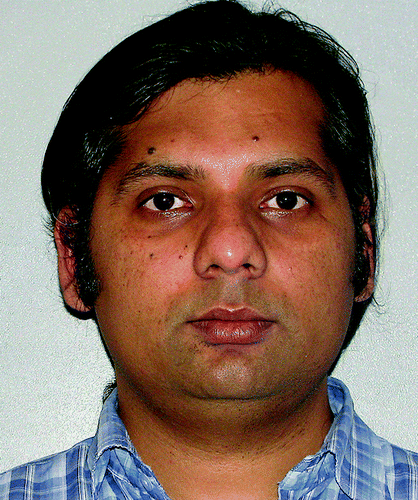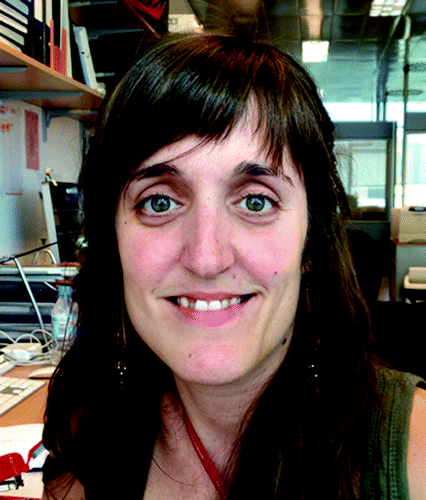Email: [email protected]
Research focus
Mechanism of mitophagy and its relevance in neurodegenerative diseases.
Model system
Primary neuronal cultures and immortalized cell lines.
Education and career
2007, PhD in biological science, Central Drug Research Institute, Lucknow, Uttar Pradesh, India; advisor: Uday Bandyopadhyay. 2007–present, postdoctoral fellow, Department of Pharmacology, University of Tartu, Tartu, Estonia; advisor: Allen Kaasik.
Why do you study autophagy?
There are many open questions relevant to human health and diseases in the vast field of autophagy. Specifically, I am interested in studying the role of PARK2/PARKIN, PINK1 and SNCA/α-synuclein in mitophagy. This is what drives me to study autophagy.
What do you think is a key question in the autophagy field and/or where do you think the field is heading?
To my understanding, the key question would be the mechanism(s) that control the pro-cell survival and pro-cell death aspects of autophagy. I think that the autophagy field is heading toward finding causes and treatments of diseases that are ailing the human population.
Why is the field of autophagy important to you?
For me involvement of autophagy in development, health and diseases makes the field important.
What do you hope to achieve in your scientific career?
I hope to contribute my share in the field of mitophagy as an autophagy investigator. Particularly, I want to decipher what are the key molecules involved in mitophagy, their specific roles and their interactions. Other members in Prof. Kaasik’s lab work on diverse aspects of mitochondria function and quality control, which include studies on mitochondrial dynamics and its role in mitophagy, studies on communication between the endoplasmic reticulum-mitochondria, and Ca2+ signaling.
Personal comments
I like to know and use new technologies, which make life easier for everyone. The importance of new technologies was something I realized after coming to Estonia, my current place of work. Estonia is a small country in the EU, but it is a great place to work as individuals have the freedom to pursue their ideas, the freedom to express their opinions without any fear, and there is a very well-organized infrastructure.
Email: [email protected]
Research focus
Roles of autophagy in tissue regeneration and stem cell regulation.
Model system
Planarians and mice.
Education and career
2000, biology degree, University of Barcelona, Barcelona, Spain; 2000–2006, PhD in genetics, University of Barcelona; advisor: Emili Saló i Boix. 2006–2009, postdoctoral fellow, University of Nottingham, Nottingham, UK; advisor: Aziz A. Aboobaker. 2009–2011, Anne McLaren Fellow, University of Nottingham. 2011–current, postdoctoral fellow, Fundación Centro Nacional de Investigaciones Cardiovasculares Carlos III (CNIC), Madrid, Spain; advisor: Ignacio Flores Hernández.
Why do you study autophagy?
I am interested in understanding the roles of autophagy during the process of tissue regeneration and stem cell regulation. I use the planarian model system, an invertebrate model with the astonishing power of full-body regeneration. This regenerative power resides in a pool of pluripotent stem cells, making the planarian a very useful model system to study stem cell biology. My contribution to the understanding of autophagy function during regeneration is based on two findings. First, my work identified the gene dap-1, the planarian homolog of human DAP/death-associated protein, as a regulator of autophagy in planarians. This study showed that dap-1 is necessary for planarian regeneration and body remodeling during planarian normal homeostasis. We suggested a role of dap-1 in cell death related to autophagy. Interestingly, we also found that dap-1 regulates stem cell proliferation. However, we were not able to show if this regulation was either autophagy-dependent or stem cell autonomous. Second, others and I have shown that MTORC1 is necessary for the initial mitotic response to injury and blastema formation. Although RNAi animals for the MTORC1 components could not form a blastema, stem cells in the old tissue were able to differentiate the missing structures at the old stump. Together, these findings suggest the possibility of autophagy being involved in stem cell regulation. I am currently trying to understand which of the effects observed after MTORC1 inhibition are due to an increase in autophagy. I am also developing autophagy detection tools in order to be able to follow this process during planarian regeneration and starvation.
Planarians are clearly an interesting system with regard to their capacity for regeneration, but what led you to choose to work with this organism? For example, I assume genetic manipulations in planarians are not trivial
I started to work with planarians as an undergraduate student, and encountered an amazing organism about which very little was known. I had already heard about the capabilities of these animals in several lectures at the university, and there were so many questions that I wanted to answer about how regeneration is happening, how is it possible that they have so many stem cells, or how they are able to survive long periods of starvation, so that I decided to do a PhD in this model system. My interest in planarians has grown ever since, and it is just amazing how far the planarian system has come since I started my career cloning Hox genes using degenerated primers.
Which paper in your research field represents seminal work on autophagy?
Being a developmental biologist, the research papers that for me represent outstanding findings are basically the ones that have been able to relate autophagy to developmental processes. From my point of view, the Baehrecke lab working with Drosophila has been doing an amazing effort showing at the molecular level that apoptosis is not the only way to achieve programmed cell death, and that cell death can be initiated by autophagy. This alternative way of programmed cell death related to autophagy was observed in numerous developmental processes and morphologically described in the older literature. However, a molecular characterization and acceptance by the larger scientific community was missing. I would emphasize their papers in Development (2001) and Cell (2007). These papers show that salivary gland cell death occurs by autophagy, and that autophagy is necessary for this kind of cell death. Another paper that has had a large impact on me is the work from the Mizushima lab (in particular, the paper in Science, 2008) showing that autophagic degradation of cytoplasmic constituents within early mice embryos is essential for preimplantation development. And finally, the paper by the Zhang lab in Cell (2009) where they showed that autophagy directed by SEPA-1 is required for the specific clearance of germline proteins from the somatic cells in the developing nematode embryo. This work is especially interesting because it suggests that some autophagy proteins may be involved in the process of cell fate determination during development, and because it links autophagy and stem cell regulation.
What do you think is a key question(s) in the autophagy field?
A key question is what are the roles of autophagy in the regulation of stem cell maintenance, and whether autophagy is a process involved in stem cell aging.
What do you hope to achieve in your scientific career? If you could start over and choose a different career, what would it be?
I have been working with planarians for more than 10 years and I am still fascinated when I observe their regeneration process under a microscope. It is a privilege that I can dedicate my life to study how these animals do this, and I would feel very fortunate if I can continue doing research on these animals. I would not choose a different career if I could start over. If I couldn’t choose the same career, then I would choose to be Minister of Science in Spain, in order to increase the research budget to decent levels, giving jobs to the many talented scientists of Spain that currently have to emigrate or work in McDonalds.
Personal comments
I like traveling, hiking and planarian hunting. I have fond memories about field excursions to collect planarians with the lab during my PhD, when we spent hours standing in the river, plucking planarians from underneath stones. I love to visit and admire great landscapes, and I am always looking for a more surprising landscape to discover. I like swimming and I also love dancing, especially salsa and bachata. In the past five years I have started to collect different species of epiphytic orchids and currently I have a collection of 43 species. Hopefully my Darwin orchid will flower one day!
Email: [email protected]
Research focus
Control of autophagy during both physiological development and in stress conditions in the sea urchin embryo.
Model system
Sea urchin embryo and larvae in development.
Education and career
1971, biology degree, University of Palermo, Italy; advisor: G. Giudice. 1972–1973, fellowship from the Italian Ministry of Public Education, Institute of Comparative Anatomy, University of Palermo. 1974–1980, associate scientist at the Institute of Comparative Anatomy, University of Palermo. 1981–2005, associate professor of cell biology, Department of Cell and Development Biology, University of Palermo. 2000–2005, member of the scientific committee for PhD in “Biotechnology applied to prenatal medicine.” 2006–present, full professor of cell biology, in the Department of Molecular and Biomolecular Sciences and Technologies (STEMBIO) Section of Cell Biology, University of Palermo; 1995-present, member of the scientific committee for PhD in “Cell Biology and Drugs Technology” (Cell Biology). 2000–2003 and 2008–present, vice-head of the School of Natural Sciences.
Why do you study autophagy?
My interest in autophagy is to understand how autophagy contributes to cell differentiation in the development of embryos as well as to the ability of embryos to defend themselves against environmental stresses, including the remodeling of an alternative phenotype. I recently observed that autophagosomes/autolysosomes are present in different numbers depending on the stage of development, but increase greatly under stress. Furthermore, my interest is to recognize the molecular pathways that, both during physiological development and in stress conditions, the embryo uses. I am also interested in investigating the relationship between autophagy and the apoptotic process, because in sea urchin embryos, apoptosis is used to remove irreversibly damaged cells as a response to stress. In addition, I am extending my research on autophagy and apoptosis in human granulosa cells and cumulus oophorus, as part of medical-assisted reproduction, in order to select the best corresponding oocyte, for fertilization.
What do you think is a key question in the autophagy field?
Autophagy is a process that enables the cell to choose to live or die. The main goal would be to understand the molecular pathways through which this process regulates survival or death, in order to use this ability to tip the balance one way or another. In this way we could push the cell toward survival in the case of excessive cell death, as in aging, or vice versa push toward death, as in tumorigenesis.
Is teaching a substantial part of your current position?
As a professor of cell biology at the university, I explain the main processes involving the cell, including apoptosis and autophagy. The research that I discuss certainly makes the content of my lectures more interesting and at the same time students are a good stimulus because they always ask new questions. In addition, this year, I was tutor of a doctoral thesis of a subject about the autophagic process in sea urchin embryos exposed to stress.
Personal comments
In my free time I love traveling, visiting archeological sites (Egypt, Turkey, Greece) and taking photos, especially of natural landscapes (national parks: Banff and Glacier of Canada, Denali of Alaska, Monument Valley, Doñana of Spain, Sahara Desert). Moreover, I like reading contemporary literature (my favorite authors: Calvino, Marquez, Tabucchi, Camilleri, Vitali) and listening to jazz music.
Email: [email protected]
Research focus
Identifying metazoan-specific autophagy genes; studying how protein aggregates are selectively recognized and degraded by autophagy under physiological conditions.
Model system
C. elegans.
Education and career
2001, PhD in molecular genetics, Albert Einstein College of Medicine, NY, USA; advisor: Scott Emmons. 2001–2004, postdoctoral fellow, Massachusetts General Hospital Cancer Center, Harvard Medical School, USA; advisor: Daniel Haber. 2004–2009, assistant investigator, National Institute of Biological Sciences (NIBS), Beijing, China. 2009–2012, associate investigator, NIBS. 2012-present, investigator, Institute of Biophysics, Chinese Academy of Sciences, Beijing, China. 2012-present, HHMI International Early Career Scientist.
Why do you study autophagy?
I entered the autophagy field accidentally. My lab was using C. elegans as a model to study cell fate specification. In 2007, we performed a genome-wide RNAi screen to identify genes involved in germ-soma specification. We found that loss of autophagy activity causes accumulation of germline-specific P granule components, termed PGL granules, in somatic cells. We further demonstrated that in addition to PGL granules, a variety of protein aggregates, including the C. elegans SQSTM1/p62 homolog SQST-1, is selectively removed by autophagy during embryogenesis. Using this as a genetic model, we performed genetic screens to identify mutants that accumulated components of PGL granules and SQST-1. In addition to conserved yeast ATG gene homologs, we have also identified multiple autophagy genes whose homologs are conserved in mammals but are absent in yeast. We are developing other genetic screening strategies to isolate genes essential for autophagy.
We are also identifying genes required for the degradation of specific types of protein aggregates. Characterization of such genes will help reveal how protein aggregates are selectively recognized and targeted to the autophagy machinery. Recently, my lab also established a genetic model to study starvation-induced autophagy in C. elegans and we are investigating how autophagy activity is regulated under physiological conditions and how it is integrated with various signaling pathways during animal development. Our studies will provide insights into how dysregulated autophagy activity contributes to various pathological conditions and also how to promote autophagic degradation of protein aggregates associated with neurodegenerative diseases and clearance of invading pathogens.
What do you think are key questions in the autophagy field?
The signal that triggers initiation of the phagophore; the membrane source for autophagosome expansion; the interplay between autophagy and the endolysosomal system; the mechanism for endowing cargo specificity during selective autophagy.
What do you hope to achieve in your scientific career?
We would like to take advantage of the wealth of knowledge about C. elegans developmental biology and the availability of powerful experimental tools to make C. elegans a good model to address some important questions in autophagy and hopefully help us to understand how dysregulated autophagy activity contributes to pathological conditions such as neurodegenerative diseases in humans.
Is there a key experiment/finding from your lab that stands out in your mind with regard to autophagy?
The discovery of degradation of germline-specific P granule components in somatic cells is an excellent example showing the power of genetics.
Personal comments
I play badminton every day to boost levels of autophagy.



